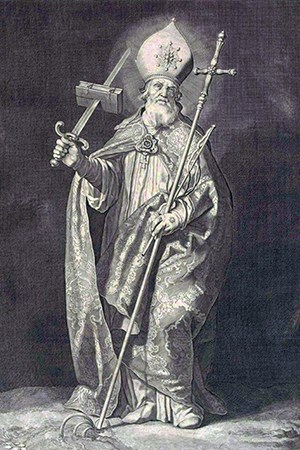What does an 8th century AD English monk, missionary and reformer have to do with the Christmas tree in your living room? Actually, more than you might think. Let’s take a look…
The man
The man known to history as St. Boniface was born with the name Winfred in Wessex, England in 675 AD. His family was respected and prosperous which enabled young Winfred to receive a good education. Against his father's wishes, he decided at an early age to become a Benedictine monk and join a monastery.
Winfrid taught in the abbey school, wrote a Latin grammar, and became a priest at age 30. When the monastery abbot died, he was elected to replace him. He declined the honor as he now felt God’s calling to mission work on the continent. He received the full support of the Pope (Gregory II) who changed his name to Boniface in 718 and commissioned him as a missionary bishop to the pagan tribes east of the Rhine River. He was 43. His namesake was the 4th century martyr, Boniface of Tarsus. Many years later, he would suffer the same fate.
The missionary
Boniface’s early missionary work in Frisia (Netherlands) and Germania (Germany) was hindered by resistance from a local king and a war raging in Europe. However, he did not give up but kept preaching with a fellow English bishop named Willibrord. Gradually, their pioneer work began to bear fruit. As pagans became believers, Boniface established monasteries throughout the region. He became known as “the apostle to Germany”.

The best-known story of Boniface’s bravery and determination concerned a sacred oak tree worshipped by pagans. He decided to chop it down. According to an early biographer, as Boniface began his dangerous mission, a strong wind arose and finished the job. The locals expected their Germanic god, Thor, to strike the offender dead. Nothing happened. The people became Christians and Boniface used the wood to build a chapel.
Boniface also noticed a little fir tree nearby and said, “This little tree, a young child of the forest, shall be your holy tree tonight. It is the wood of peace… It is the sign of an endless life, for its leaves are ever green. See how it points upward to heaven. Let this be called the tree of the Christ-child; gather about it, not in the wild wood, but in your own homes; there it will shelter no deeds of blood, but loving gifts and rites of kindness.” Thus began the Christmas tree tradition which (centuries later), German immigrants brought to the New World.
During his ministry, Boniface was supported and protected by Charles Martel, the most powerful leader of the region. This undoubtedly helped his efforts. During his long life, Boniface served under three Popes and made several trips to Rome. Historians know a lot about his life and ministry from his prolific letter-writing and sermons. In 751 AD, he was made an archbishop at age 76. However, he would not die a natural death.
The martyr
Three years later, Boniface returned to the region of Frisia (Netherlands) where he had begun his work many years before. A large group of people were baptized at that time but on Pentecost Sunday, a band of armed pagan robbers killed him (and 52 other believers) as he was reading the Scriptures during a worship service. His last words to his followers were reportedly, “Cease fighting. Lay down your arms, for we are told in Scripture not to render evil for evil but to overcome evil by good."
The robbers were disappointed. "They broke open the chests containing the books and found, to their dismay, that they held manuscripts instead of gold vessels, pages of sacred texts instead of silver plates." The Gospel Boniface was reading was damaged but survived and can be viewed today. He was 79.
Boniface’s tomb became a destination for Christian pilgrims. He is remembered as an organizer, educator, and reformer who made a profound impact on the development of Europe during the Middle Ages. His monasteries trained many Christian leaders for future generations. He was made the “patron saint of Germany” (similar to St. Patrick’s status in Ireland). Many statues and plaques in England, Europe and beyond honor him. St. Boniface (near Winnipeg) is named after him. His feast day is June 5, the day he was martyred.
So, when you decorate your Christmas tree this year, think of St. Boniface — a remarkable missionary who gave his life to bring the Gospel to Europe almost 13 centuries ago.
Rob Weatherby is a retired pastor.

